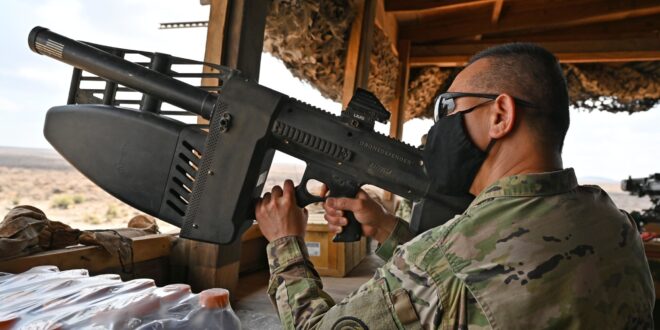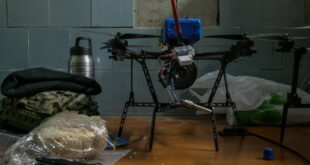U.S. Army Maj. Gen. Lapthe C. Flora, commanding general, Combined Joint Task Force-Horn of Africa (CJTF-HOA), operates a Drone Defender V2 during his visit to Chabelley Airfield, Djibouti, Oct. 31, 2020. (U.S. Air Force photo by Tech. Sgt. Dana J. Cable)
GULFPORT, Miss. — Warning of “growing hostile surveillance and active targeting” in Africa and threats to US forces in the Red Sea, US Africa Command put counter-uncrewed systems and integrated air defenses at the top of its $500 million unfunded priorities list (UPL) sent to lawmakers.
“It is only a matter of time before U.S. forces in East Africa are attacked by an enemy [uncrewed system], cruise or ballistic missile,” the wishlist says. “Efforts to develop integrated detect, track, identify, and defeat capabilities […] must be placed on resourcing trained operators as they prepare to deploy.”
RELATED: Army, CENTCOM ask Congress for spending jump for counter-drone mission
The fiscal 2025 UPL, obtained by Breaking Defense and provided to lawmakers last month, says that given another half-billion dollars, AFRICOM would spent $219 million to “support a layered base defense configuration” involving a National Advanced Surface-to-Air Missile System (NASAMS), interceptors, radars and other “short-range air defense equipment to counter” small- to medium-sized drones.
UPLs are congressionally mandated reports sent to Congress from each military branch and combatant command, listing the entity’s top priorities that did not make it into the formal budget for that year. AFRICOM’s list was previously reported by Inside Defense.
AFRICOM is hardly alone in its focus on counter-drone systems, as the US Army and US Central Command both included cUAS systems on their unfunded priorities list after the conflict in Ukraine highlighted the potency of drone and loitering munition attacks.
RELATED: Running down the Pentagon’s unfunded wish lists for Congress
After the counter-uncrewed systems, AFRICOM said it would spend another $228 million on “high-risk intelligence, surveillance and reconnaissance” services and an increased “bandwidth” in ISR collection requirements.
“Current shortfalls in ISR solutions create unacceptable risk to deployed service members in Africa,” the command said.
“Without adequate airborne ISR to meet the Command’s requirements for persistent collection, USAFRICOM will be unable to successfully execute counter terrorism operations, provide timely intelligence to counter People’s Republic of China (PRC) and Russian efforts, fulfill non-combatant evacuation operations (NEO)” and several other missions. “Further details on these risks to mission and risks to force are available at a higher classification level,” it teases. (Virtually the entire list is marked CUI, the controversial designation for “controlled unclassified information”.)
In Congressional testimony on March 4, AFRICOM chief Gen. Michael Langley said America’s “largest facility in Africa is in Djibouti, a few minutes’ drive from the People’s Republic of China’s only overseas military base.”
“Beijing is deeply invested in the Horn of Africa, as it is across the African continent,” he said.
RELATED: EUCOM asks for $83M for air base defense in FY25 unfunded wishlist
AFRICOM’s UPL specifically notes that “commercial ISR services” can be a “critical capability bridge to meet operational demands while Services pursue ISR modernization efforts.”
Beyond those two high-priced items, AFRICOM’s UPL consists of five other programs, totaling less than $50 million, including equipment for a data integration team, money for additional Security Force Assistance Brigade deployments and “long endurance airborne” ISR.
 Unmanned Aerial Vehicle The latest drone news
Unmanned Aerial Vehicle The latest drone news




